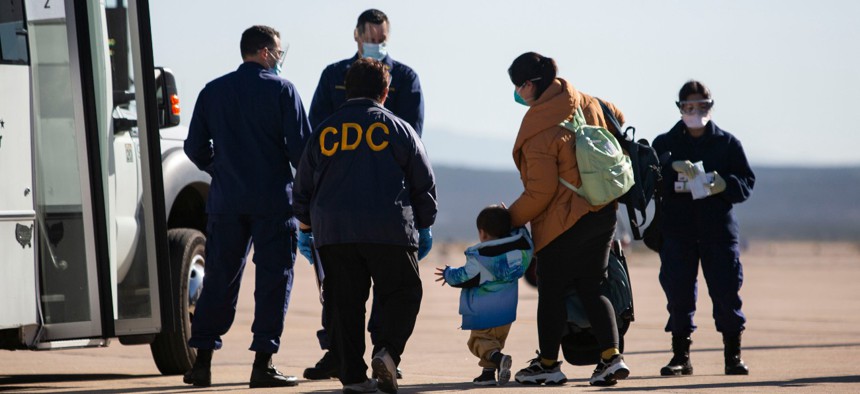
Evacuees from China arriving at Marine Corps Air Station in Miramar, Calif., on Feb. 5, 2020 HHS photo via AP
Faulty Planning and Coordination Hampered the Government's Early Pandemic Repatriation Efforts
"Serious" and "fundamental" challenges put feds, American public's health and safety at risk, GAO finds.
Poor planning and a lack of interagency and inter-component coordination led to widespread confusion as the federal government began its COVID-19 response, according to a new report focused on the early 2020 efforts to repatriate Americans overseas.
The failures put the health and safety of federal employees, evacuated U.S. travelers and the American public at risk, the Government Accountability Office found in a report issued Monday after a 13-month investigation. Divisions of the Health and Human Services Department did not know who should take charge of the repatriation initiative and still to this day point the finger at each other when asked who led the campaign last year.
HHS’ Administration for Children and Families should lead any repatriation effort, according to a previously developed framework, but the department’s general counsel opted to change the effort from a repatriation to an “evacuation and quarantine.” That shifted primary responsibility to the Centers for Disease Control and Prevention, though CDC told GAO it was never notified of that decision. The end result was “confusion and frustration,” according to Defense Department officials involved while the quarantined individuals were housed at military bases, and leadership from ACF, CDC and HHS’ Office of the Assistant Secretary for Preparedness and Response each telling GAO someone else was leading the effort. All three components informed the investigators they were simply providing support to the other agencies, leading officials at HHS, Defense and the State Department to all complain of a disorganized campaign.
Each HHS component operated independently of each other, GAO found, leading to several operational questions. Officials were unclear about how to finance the initiative, obtain proper security clearances or manage the health and safety of their workers. Deployed personnel had no familiarity working with each other, GAO said, leading to further communication failures. As previously disclosed by internal HHS reports launched after whistleblower complaints and made public by the Office of Special Counsel, those deployed received no training before their deployments and mixed messaging on the need for personal protective equipment around quarantined individuals.
An ASPR incident management team eventually helped take charge at the first quarantine site in California, but it did not arrive until three days after the repatriated Americans. Even then, confusion over leadership roles persisted.
“While HHS noted that ASPR took control of the operation, ASPR’s on-site personnel operated under the belief they were in a support role and that this was an ACF and CDC mission,” GAO said.
According to planning documents reviewed by GAO, ACF should plan, coordinate and execute repatriation efforts. ASPR would provide support as needed and CDC would issue guidance on screening of individuals, their movement and quarantine procedures. While the agencies implemented the plan previously—such as after an earthquake in Haiti or when war broke out in Lebanon—it was never employed during a pandemic event. They had conducted many exercises over the years to prepare for pandemics, but none of them included repatriation initiatives. In April 2019, HHS led a whole-of-government training for responding to an influenza pandemic coming from China. At no point, however, did it prepare for evacuating Americans overseas.
While officials pointed to the HHS general counsel decision to redefine the initiative as causing confusion, none could define any difference between a repatriation and an evacuation or how the procedures would change under each scenario. The lack of leadership and communication was evident from the get go after CDC warned against allowing those who had tested positive for COVID-19 to travel with other Americans but ASPR signed off on it anyway. HHS experienced “serious, fundamental coordination challenges,” GAO said.
HHS, State and Defense repatriated a total of 1,100 Americans who were located in the Hubei region or passengers on a cruise ship where a COVID-19 outbreak occurred. They ceased those efforts and the quarantining process after they determined the virus was already present in the U.S.
Absent changes, GAO said, the government will continue to flounder in similar situations going forward. HHS agreed to issue clearer guidelines on repatriation roles and responsibilities, noting ACF will be in charge in future efforts. That was despite the objections of the HHS employee whose whistleblowing led to several investigations, who said ACF employees were ill suited for the task and their deployments put the public’s safety at risk. The department also vowed to incorporate repatriation into its training exercises.







